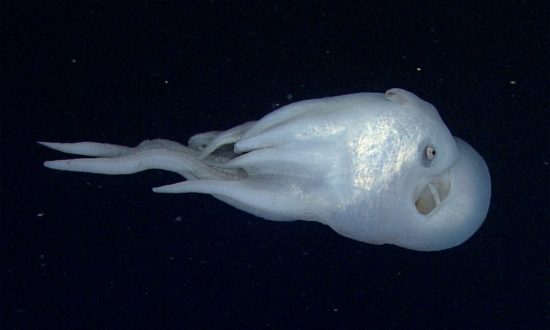
This frame grab from deep-sea video shows a female octopus, Haliphron atlanticus, swimming through the water. The octopus's body is about 30 cm (one foot) across. MBARI researchers recently discovered that that these unusual octopuses eat jellyfish.
(c) 2013 MBARI / Screenshot Video

This frame grab from deep-sea video shows a female octopus, Haliphron atlanticus, swimming through the water. The octopus's body is about 30 cm (one foot) across. MBARI researchers recently discovered that that these unusual octopuses eat jellyfish.
(c) 2013 MBARI / Screenshot Video

This frame grab from deep-sea video shows a female octopus, Haliphron atlanticus, holding an egg-yolk jelly in her arms. The octopus's body is about 30 cm (one foot) across. MBARI researchers recently discovered that that these unusual octopuses eat jelly (c) 2013 MBARI / Screenshot Video

This frame grab from deep-sea video shows a female octopus, Haliphron atlanticus, holding an egg-yolk jelly in her arms. The octopus's body is about 30 cm (one foot) across. MBARI researchers recently discovered that that these unusual octopuses eat jelly
(c) 2013 MBARI / Screenshot Video

This frame grab from deep-sea video shows a female octopus, Haliphron atlanticus, holding an egg-yolk jelly in her arms. The octopus's body is about 30 cm (one foot) across. MBARI researchers recently discovered that that these unusual octopuses eat jelly
(c) 2013 MBARI / Screenshot Video
Octopus then uses tentacles of jellyfish to defend itself
The open ocean is the largest habitat on Earth. Within this expansive
and uninhibited realm, the marine creatures can grow to enormous sizes.
Despite their size, many questions about their lives and behaviour
remain unresolved.
The sheer expanse and depth of our oceans makes it difficult for us to
study the animals that live there. Seemingly basic questions like what
they eat is a challenging mystery that can take decades to solve.
However, thanks to advances in underwater technology, it is now easier
to observe deep-sea animals in their natural habitat.
A new study, published in Scientific Reports, by Henk-Jan Hoving of
GEOMAR Helmholtz Centre for Ocean Research Kiel and Steve Haddock of
Monterey Bay Aquarium Research Institute (MBARI) reveals a surprising
truth about the deep-sea octopus Haliphron atlanticus: Its choice of
prey is the jellyfish.
Much of this octopus' life is a mystery. In fact, it has been spotted
by MBARI researchers only three times in 27 years. It is rarely caught
alive; much of our knowledge about them comes from specimens caught in
trawl nets.
This octopus lives in the deep pelagic ocean, and belong to a group of
octopods called Argonautoidea. They are generally small in size, but
the female Haliphrons are giants, measuring as long as four metres, and
weighing up to 75 kilogrammes. In contrast, the males are only about 30
centimetres.
Using remotely operated vehicles (ROVs), MBARI scientists now have the
ability to locate such elusive creatures like the Haliphron in the deep
sea. With these devices, they can use high-resolution cameras to zoom
in or to follow the animal to observe its behaviour.
On a recent cruise, Haddock's team chanced upon a Haliphron and
followed it. Then, when it spread out its tentacles, they were suprised
to see a large jellyfish firmly cradled in its grasp.
Later, Hoving and Haddock searched through the MBARI archives, and
managed to find two records of the Haliphron. They saw that the animals
were holding something in their tentacles. Unfortunately, it was
difficult to see what the octopuses were holding, due to the cape-like
webbing between their tentacles. At the very least, it was obvious that
at least one of them was also carrying a gelaninous organism.
In addition, Hoving analysed the stomach contents of five specimens,
and discovered that they all contained gelatinous zooplankton. For
three of them, their stomach contents were easily identifiable as
jellyfish.
This set of evidence – the sightings, stomach contents and literature
observation – strongly proves that the haliphron atlanticus feeds on
gelatinous zooplankton.
In the open ocean, gelatinous zooplankton are abundant. Thus, it makes
sense for the haliphron, a large, slow-moving animal, to prey on them.
Similar, other large pelagic animals like the leatherback sea turtles,
tuna and large pelagic fish also eat jellyfish.
Although the “flesh” of these jelly-like animals are generally
perceived to be nutrient deficient, the animals that eat them tend to
be very big in size. In addressing this paradox, Haddock suggests that
the net weight of the jellyfish may translate into substantial biomass,
making up for the lack of nutrients.
In addition, Hoving and Haddock suggest that it is possible that after
consuming the nutritious parts of the jellyfish, the female haliphron
atlanticus uses their stinging tentacles as a tool.
Due to her large size, they can completely grasp a jellyfish within
their webbed tentacles. Upon catching it, they bite through the bell of
the jelly to get to the food within its digestive cavity. Although the
jellyfish is dead at this point, its bell and fringe are still intact.
Based on how the octopus is holding the jellyfish, Hoving and Haddock
postulate that it is using the jellyfish's tentacles for defence or to
capture more prey.
Written by
Herbert
Date
30th March 2017







 Herbert
Herbert 30th March 2017
30th March 2017